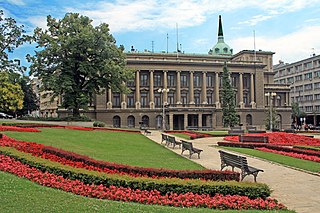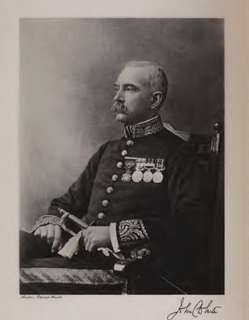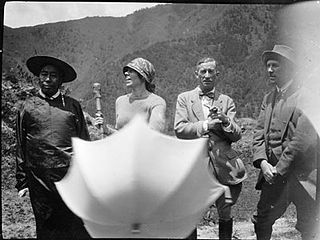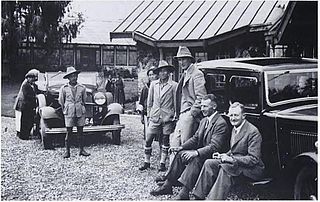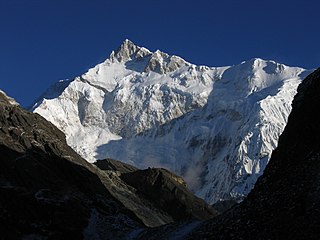
Sikkim is a state in northeastern India. It borders Tibet in the north and northeast, Bhutan in the east, Nepal in the west, and West Bengal in the south. Sikkim is also located close to India's Siliguri Corridor near Bangladesh. Sikkim is the least populous and second smallest among the Indian states. A part of the Eastern Himalaya, Sikkim is notable for its biodiversity, including alpine and subtropical climates, as well as being a host to Kangchenjunga, the highest peak in India and third highest on Earth. Sikkim's capital and largest city is Gangtok. Almost 35% of the state is covered by the Khangchendzonga National Park.

The Raj Bhavan, formerly known during British India as the Bangalore Residency, the Mysore State Residency, or, simply, the Residency, is the official residence of the Governor of Karnataka. It is located in the capital city of Bangalore, Karnataka. During Mysore Kingdom, the building was home to the Resident of the British Agency that was in subsidiary alliance with the Kingdom of Mysore.

The history of Sikkim an area in present-day North-East India, began in 1642 as a kingdom established when India and Nepal were still many princely states with many rulers at that time and had not unified to the present Union of India and present country of Nepal. At that time Sikkim had already solidified into country then with a king known as a Chogyal or dharma king, and till 16 May 1975 was an independent country ruled by the monarchs. Sikkim had twelve kings; Palden Thondup Namgyal was the last king of Independent Sikkim. There was contacts between ancient Hindus and Tibetans, followed by the establishment of a Buddhist kingdom or Chogyal in the 17th century. Sikkim emerged as a polity in its own right against a backdrop of incursions from Tibet and Bhutan, during which the kingdom enjoyed varying degrees of independence. In the early 18th century, the British Empire sought to establish trade routes with Tibet, leading Sikkim to fall under British suzerainty until independence in 1947. Initially, Sikkim remained an independent country, until it merged with India in 1975 after a decisive referendum. Many provisions of the Indian constitution had to be altered to accommodate the international treaties between Sikkim and India.

Raj Bhavan is the official residence of the Governor of West Bengal, located in the capital city Kolkata. Built in 1803, it was known as Government House before the independence of India.
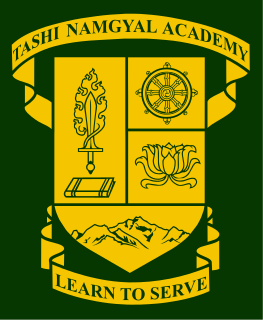
Tashi Namgyal Academy (TNA) is a public school in the Himalayan state of Sikkim in India. It was founded in 1926 by the late Sir Tashi Namgyal, KCSI, KCIE, the 11th consecrated Ruler of Sikkim. It is an autonomous English-medium, co-educational and residential-cum-day school.

Thutob Namgyal was the ruling chogyal (monarch) of Sikkim between 1874 and 1914. Thutob ascended to the throne succeeding his half-brother Sidkeong Namgyal who died issueless. Differences between the Nepalese settlers and the indigenous population during his reign led to the direct intervention of the British, who were the de facto rulers of the Himalayan nation. The British ruled in favour of the Nepalese much to the discontent of the chogyal, who then retreated to the Chumbi Valley and allied himself with the Tibetans.
The Raj Bhavan at Darjeeling is the Summer residence for the Governor of West Bengal, It is located in the city of Darjeeling, West Bengal.
Raj Bhavan is the official residence of the Governor of Kerala. It is located in the capital city of Thiruvananthapuram, Kerala. Built in 1829 as Palace Guest house of Travancore Government Guest, this heritage structure hosts the present governor of Kerala is Justice (Retd) P Sathasivam.
Raj Bhavan is the official residence of the Governor of Madhya Pradesh. It is located in the capital city of Bhopal, Madhya Pradesh.

Raj Bhavan of Pune is the monsoon residence of the Governor of Maharashtra. It is located in the city of Pune, in the Indian state of Maharashtra.

The Daly College is a co-educational residential and day boarding school located in Indore, Madhya Pradesh, India. It was founded by Sir Henry Daly of the British Indian Army during India's colonial British Raj. The school started in 1870 as the Residency School. It was then renamed as the East Rajkumar College in 1876, and in 1882, it came to be known as The Daly College. It was established by the Resident Governor of the erstwhile Presidency, to educate the children of the royalty, nobility and aristocracy of Central Indian Princely States of the 'Marathas', 'Rajputs', 'Mohameddans' and 'Bundelas'. It is one of the oldest co-educational boarding schools in the world.
Raj Bhavan is the official summer residence of the Governor of Jammu and Kashmir. It is located in the summer capital city Srinagar, Jammu and Kashmir. The present governor of Jammu and Kashmir is S.P Malik appointed by President Ram Nath Kovind on 21 August 2018.
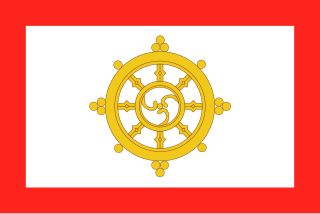
The Kingdom of Sikkim, earlier known as Dremoshong, was a hereditary monarchy from 1642 to 16 May 1975 in the Eastern Himalayas. It was ruled by Chogyals of the Namgyal dynasty.

Balmiki Prasad Singh was the 14th Governor of Sikkim, India. He is an author, thinker and a retired IAS officer. He has written number of books and articles relating to Indian culture, in particular the culture of North-East India. He was born on 1 January 1942 in Begusarai, Bihar. Among his prominent books are Bahudha and the post 9/11 World and The problem of change: a study of North East India. He presided over the four-day Global Buddhist Conference in 2011 to mark the 2,600th year of Buddha's enlightenment. Around 1,000 Buddhist scholars, thinkers and followers from over 30 countries were present. B.P. Singh is also the principal architect of the Bahudha Approach, which outlines a path towards a harmonious world, as against the clash of civilizations.

Prem Das Rai is an Indian politician from the Sikkim Democratic Front (SDF) party. Mr. Rai is currently a Member of Parliament from the Sikkim constituency of Sikkim, India, first elected in 2009 election and re-elected in 2014 after serving his first term in 2009-2014.
Karma Topden was an Indian Sikkimese politician.
The Treaty of Tumlong was a March 1861 treaty between Great Britain and the Kingdom of Sikkim in present-day north India. Signed by Sir Ashley Eden on behalf of the British and Sikkimese Chogyal, Sidkeong Namgyal, the treaty secured protection for travellers to Sikkim and guaranteed free trade, thereby making the state a de facto British protectorate.
Raj Bhavan is the official residence of the Governor of Tripura. The incumbent Governor of Tripura is Hon'ble Shri Tathagata Roy. The residence is located in the state's capital city of Agartala. A new Raj Bhavan was built and inaugurated in April 2018. The previous Raj Bhavan was built in 1917, and was known as the Pushbanta Palace prior to India's independence. The previous Raj Bhavan edifice is intended to become a museum and research center in honor of King of Tripura, Maharaja Birendra Kishore Manikya.
Mary Hepburn Scott (1887-unknown) was a Scottish Missionary and Educator who pioneered women's education in Sikkim. Despite her lack of formal medical training, she became the leading medical, educational and religious missionary in Gangtok, educating an entire generation of Sikkimese physicians and significantly improving health outcomes, despite Christian missionaries historically not being allowed in Gangtok for political and religious reasons. Scott also founded Gangtok's first girls school, the Paljor Namgyal Girls' School, which still exists today and has been credited with greatly improving the overall state of women's education in Sikkim both historically and currently. Additionally, Scott has been recognized for almost-single handedly creating the largest period of growth in Christianity in Sikkim, which still significantly impacts Sikkim's religious demographics.
